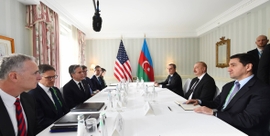Iran has begun enriching uranium to 60% purity at its fuel enrichment plant in Fordow, a year after increasing enrichment to the same level at its Natanz facility.
The Atomic Energy Organization of Iran (AEOI) announced on November 22 that “stockpiles of uranium enriched up to 60% had increased at Fordow facility,” according to the Iranian news agency ISNA.
It added that a new generation of IR-6 centrifuges had replaced older machines in Fordow to enable a massive boost in output.
Iran also installed two new IR2M and IR4 cascades at the Natanz facility, and it is preparing to inject gas into two more cascades of the same types of centrifuges, the AEOI said.
US Secretary of State Antony Blinken said on November 22 that he could not confirm whether Iran has begun refining uranium to 60% at the Fordow site.
The move came in response to the recent resolution adopted by the UN nuclear watchdog, the International Atomic Energy Agency (IAEA)’s Board of Governors, urging Tehran to cooperate with the agency's probe into the origin of uranium traces found at three old but undeclared sites.
The IAEA’s resolution adopted on November 17 was put forward by the US and E3 (France, Germany, and Britain). The resolution said that it was "essential and urgent" for Tehran to provide an explanation for traces of uranium found at three undeclared sites in Iran, and give the UN agency all the answers it requires.
According to the IAEA, Iran has failed to provide technically credible answers to its questions. Iran maintains that its nuclear program is peaceful, rejects the IAEA's assertion and accuses the agency of caving to Western and Israeli pressure.
On November 21, Iranian Foreign Ministry Spokesman Nasser Kanaani referred to Iran’s response to the resolution, saying that “at the first stage Tehran has put a few measures on the agenda of the AEOI that were implemented on November 20, at the enrichment sites of Ahmadi Roshan (in Natanz) and Alimohammadi (in Fordow) with the IAEA inspectors in attendance.”
This June, Iran removed IAEA’s monitoring equipment, including 27 surveillance cameras at several nuclear sites following the IAEA's resolution calling for Tehran to "fulfil its legal obligations".
In April 2021, Iran confirmed that the level of uranium enrichment at the Natanz nuclear site has reached 60%. The Iranian government decided to install advanced centrifuges and increase uranium enrichment to 60% purity in retaliation for the April 11 attack against its Natanz nuclear facility. Now, supplies of the radioactive metal held in at least two facilities - Fordow and Natanz - are closer to weapons-grade 90% purity.
Mohammad Eslami, the head of the Atomic Energy Organisation of Iran (AEOI), said on November 20 that the passage of a resolution critical of Iran at IAEA will be met with a "firm response".
Eslami said that Iran's nuclear program would continue in accordance with the "Strategic Measure for Lifting Sanctions", which was passed in late 2020, and demanded the paring back of Iran's adherence to its commitments under the 2015 nuclear deal (JCPOA), which had become largely non-operational after the US withdrawal in May 2018. The US then re-imposed sanctions, and Tehran backed away from its part of the deal in response. Before the deal, Iran's uranium enrichment had been at 20% purity. The deal capped it at 3.67%.







 As of April 27, additional 48 bodies were unearthed in the liberated lands of Azerbaijan, bringing the total count of discovered remains to over 600.
As of April 27, additional 48 bodies were unearthed in the liberated lands of Azerbaijan, bringing the total count of discovered remains to over 600.
 U.S. Secretary of State Antony Blinken reiterated Washington’s unwavering support for the ongoing peace process between Azerbaijan and Armenia in a...
U.S. Secretary of State Antony Blinken reiterated Washington’s unwavering support for the ongoing peace process between Azerbaijan and Armenia in a...
 President Ilham Aliyev shed light on the evolving contours of the peace process with Armenia during an international conference in Baku this week. ...
President Ilham Aliyev shed light on the evolving contours of the peace process with Armenia during an international conference in Baku this week. ...
 Turkmen President Serdar Berdimuhamedow and British Secretary of State for Foreign Affairs, Commonwealth Affairs, and Development David Cameron dis...
Turkmen President Serdar Berdimuhamedow and British Secretary of State for Foreign Affairs, Commonwealth Affairs, and Development David Cameron dis...
 A draft resolution aimed at preventing the development and deployment of weapons of mass destruction (WMDs) in outer space, co-sponsored by Japan a...
A draft resolution aimed at preventing the development and deployment of weapons of mass destruction (WMDs) in outer space, co-sponsored by Japan a...
 Kyrgyzstan has joined the extensive reconstruction efforts in the Karabakh region of Azerbaijan, after a series of mega initiatives were launched b...
Kyrgyzstan has joined the extensive reconstruction efforts in the Karabakh region of Azerbaijan, after a series of mega initiatives were launched b...



